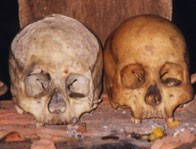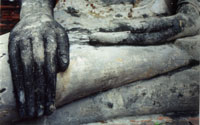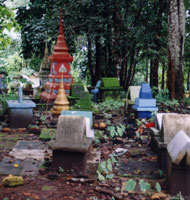Looking at Death
There is an open fascination with death in Thailand. Specialised magazines cater to on-the-spot photographs and articles detailing the most gruesome crimes and accidents. Photographs that would only be seen by a coroner often make the front page of the local newspapers. There are also companies in Bangkok that specialize in collecting the dead from accident scenes. And at the same time everyone is terrified of ghosts.
Yours truly just spent a pleasant afternoon at The Museum of Forensic Medicine. This adventure is not recommended for those who are weak in the stomach but was one of the most interesting things I have done lately.
I tried to convince some Thai friends to go with me. One said, “No way. I won’t be able to sleep at all if I go.” The other said, “I will go with you but I will wait outside. There will be too many ghosts in there.” I made the trip alone. I am sure they thought I was nuts.
The Museum of Forensic Medicine sits nestled in the gigantic mazes of Siriraj Hospital in Bangkok. I had major difficulties reaching my destination. I accidentally ended up touring the emergency room. About 27 patients in outdated stretchers with gigantic wheels were waiting to be admitted. After somehow walking through the cardiac and nephrology departments, past the prescription pick-up counter, and accidentally back out onto the street, I finally reached the museum. Up the stairs I went.
of Siriraj Hospital in Bangkok. I had major difficulties reaching my destination. I accidentally ended up touring the emergency room. About 27 patients in outdated stretchers with gigantic wheels were waiting to be admitted. After somehow walking through the cardiac and nephrology departments, past the prescription pick-up counter, and accidentally back out onto the street, I finally reached the museum. Up the stairs I went.
It was four times more gruesome than I expected. My roommate in college was a medical student and I used to check out the cadaver she was working on with no problem. I have been to my fair share of open casket venues. I have seen car accident victims. The Museum of Forensic Science topped them all. I started to wonder if eating lunch before my arrival was such a good idea.
Skeletons, mummified bodies, the bloody shirts of stab wound victims, ropes used in hangings, preserved body parts and deformed children, autopsy kits, amputated legs, bones, teeth, preserved skin with tattoos, bullet casings, and bloody knives cluttered the shelves. There was also a collection of gruesome photographs showing shootings, stabbings, overdoses, suicides, and accidental electrocutions. A variety of ruptured but preserved organs were also available for viewing.
teeth, preserved skin with tattoos, bullet casings, and bloody knives cluttered the shelves. There was also a collection of gruesome photographs showing shootings, stabbings, overdoses, suicides, and accidental electrocutions. A variety of ruptured but preserved organs were also available for viewing.
Also on display was the mummified body of the notorious executed child abductor named Si Quey. He believed that eating children’s organs would grant him eternal life. He stood upright in a glass case with a metal pan under his feet to catch the dripping moisture. A black and white photograph of Si Quey while alive was attached to the side of the case. He looked deranged indeed.
Some people stared at the displays with fascination, others with disgust. Some got up very close while others kept their distance. The thing that struck me the most about the viewing audience was the fact that many parents had brought their children along. I counted 29 adults and 19 children in attendance. One drunkard was asleep on the bench.
attendance. One drunkard was asleep on the bench.
I assumed that the parents had brought the children along as part of a religious upbringing. Buddhism teaches that life is impermanence. Monks often meditate with skeletons, corpses, or inside cremation ovens as part of their religious training. Nevertheless, it was uncanny to watch living children gazing at dead children.
Four monks, one nun, and four tourists were also part of the crowd. I asked one of the tourists what he thought of the place and he stated, “I was not expecting to see so many dead babies! Yuck!” As for me, I was expecting to be the only one there. I surprised myself and decided not to take any pictures.
I talked to several Thai people about my shock at seeing so many children at the museum. One friend told me, “Oh yes. My parents brought me to that museum when I was a child. It is not about Buddhism or a religious lesson. Parents like to tell children really scary stories. They do it to show you what can happen if you are a bad girl, if you talk to strangers, or if you do not come home on time. The parents bring you there so that you will behave. I could not sleep for six months after going there.” The following day everyone did in fact ask me if I was able to sleep after my visit. I was.
When I think back on the experience, it was not The Forensic Museum that was the most interesting or disturbing. It was my accidental tour of the hospital itself. It did not seem sterile and it definitely was not quiet, hidden, or somber. The living walked past the dying. The line to the emergency room grew longer and looked more and more desperate. No one fussed and no one screamed. Children played. People snacked. Illness was on the most public display I have yet to see. The most gruesome sights simply went wheeling by me in the hallways.
